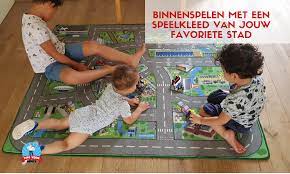In the world of infant development, playmats often take center stage as essential tools for a baby’s growth and enjoyment. These vibrant, boxkleden cushioned surfaces do much more than just provide a soft spot for babies to lie on—they stimulate sensory exploration, encourage physical activity, and foster cognitive and motor skills. As we delve into the significance of playmats, we uncover how these simple yet effective products contribute to a baby’s early development.
The Foundation of Play: What Makes Playmats Special?
Playmats, also known as activity mats or play gyms, are designed with a variety of features to captivate and engage infants. Typically made from soft, padded materials, they come in various shapes, sizes, and themes, each tailored to provide different sensory experiences.
- Sensory Stimulation: Most playmats feature a mix of textures, colors, and patterns that captivate a baby’s visual and tactile senses. From crinkly fabrics to smooth, velvety patches, these textures invite babies to explore with their hands and feet, enhancing their sensory development.
- Interactive Elements: Many playmats are equipped with hanging toys, mirrors, and sound-making objects. These interactive elements encourage babies to reach, grasp, and bat, promoting fine motor skills and hand-eye coordination. Mirrors, in particular, help babies develop visual tracking and self-recognition.
- Safety and Comfort: Safety is a top priority in playmat design. High-quality mats are made with non-toxic materials and offer ample cushioning to protect babies as they roll, crawl, or play. The soft padding provides a comfortable space for babies to explore, minimizing the impact of any accidental bumps or falls.
Developmental Benefits of Playmats
The benefits of playmats extend far beyond immediate entertainment. Here’s how they contribute to various aspects of a baby’s development:
- Gross Motor Skills: Playmats provide a designated space for babies to practice rolling, crawling, and eventually, pulling up to stand. The freedom to move on a soft surface helps develop muscle strength and coordination.
- Cognitive Growth: The diverse stimuli on a playmat—bright colors, different textures, and engaging toys—help stimulate a baby’s brain. This exposure aids in cognitive development, fostering curiosity and problem-solving skills as babies interact with their environment.
- Social Interaction: Playmats often become a central hub for social interaction between babies and their caregivers. Tummy time, facilitated by playmats, encourages bonding and communication, while caregivers can use the playmat as a platform for playful interaction and language development.
Choosing the Right Playmat
Selecting the perfect playmat involves considering a few key factors:
- Size and Portability: Playmats come in various sizes, so choose one that fits comfortably in your space and can be easily moved or stored. Some mats are also designed to be portable, making them ideal for trips and outings.
- Material and Cleanability: Opt for mats made from non-toxic, easy-to-clean materials. Babies can be quite messy, so a playmat that can be wiped down or machine washed will save time and effort.
- Design and Features: Choose a design that aligns with your baby’s developmental stage and interests. Whether it’s a mat with hanging toys, a soft and simple surface, or an interactive mat with learning elements, the right features can enhance your baby’s playtime experience.
Conclusion
Playmats are more than just a play surface; they are a crucial component in a baby’s developmental journey. By offering a safe, engaging, and stimulating environment, playmats support physical, cognitive, and sensory development while providing endless opportunities for fun. As you explore the world of playmats, you’ll find that each one offers a unique combination of features designed to enrich your baby’s early experiences.

